Are you a beginner who wants to learn to can peaches in syrup? Look no further than this post!

I’m so glad you’re here to learn how to can peaches in syrup. It’s an excellent way to save up a bit of summer flavor for the cold, winter months.
Any time you tackle a canning project, start by gathering your tools and ingredients. On the tool side, you’ll need a large pot to serve as your boiling water bath canner (you can find more detail about that here), as well as a rack to drop in the bottom. This lifts the jars off the bottom of the pot and allows the water to circulate. I often use the flexible silicone trivet pictured above, but a round cake cooling rack is also a really good option.

When you’re ready to get started, take the jars out of their packaging. Remove the lids and rings and wash the jars, lids, and rings in warm soapy water. I’ve been in the factory where Ball jars are fitted with lids, boxed, and sealed and it not a sterile environment. Those jars my look clean, but they’re filled with factory dust and residue. Wash them.
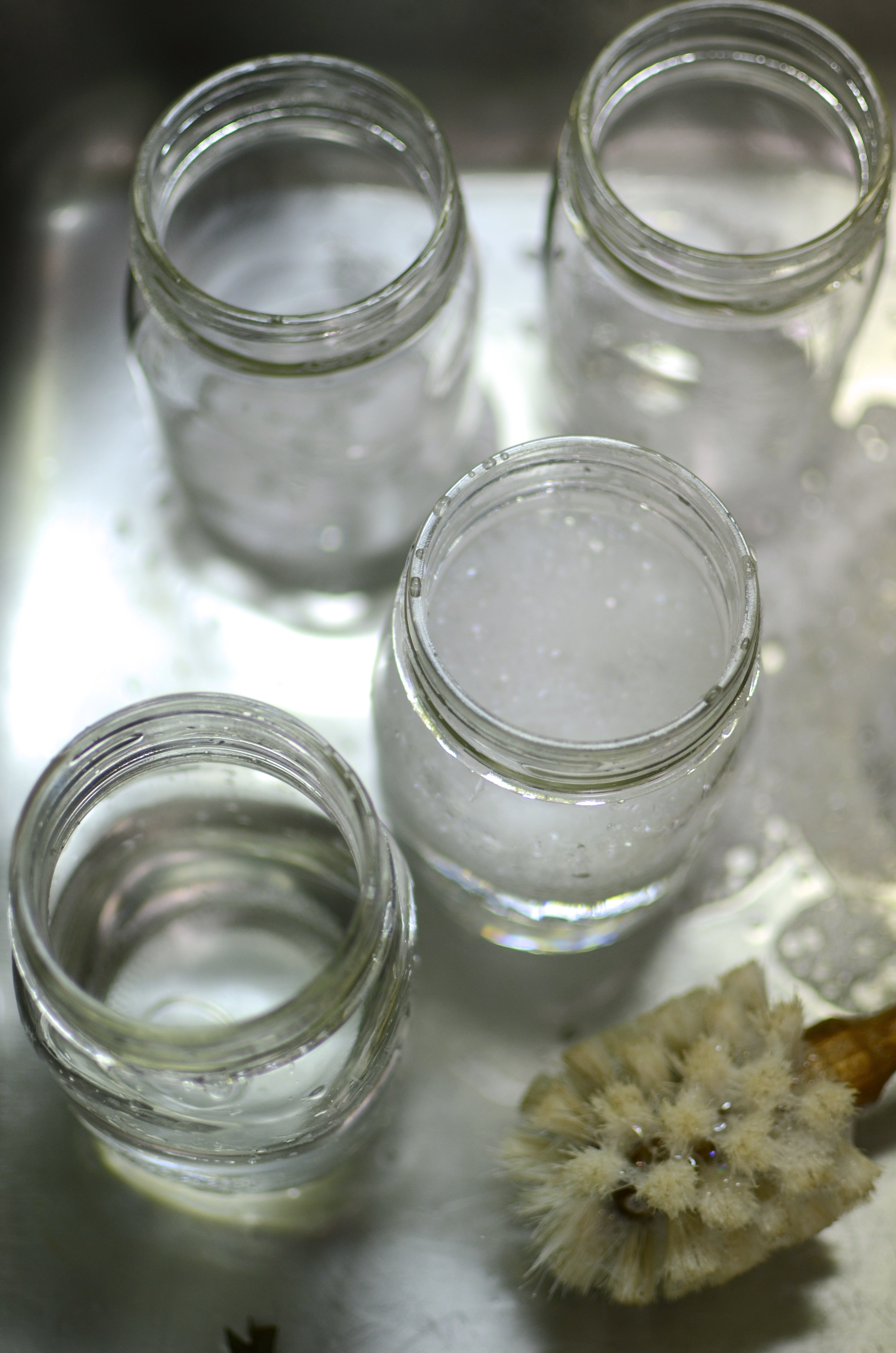
If you’re using jars that have already been used once or twice, make sure you check the rims for any chips or cracks that could prevent the jars from sealing properly.
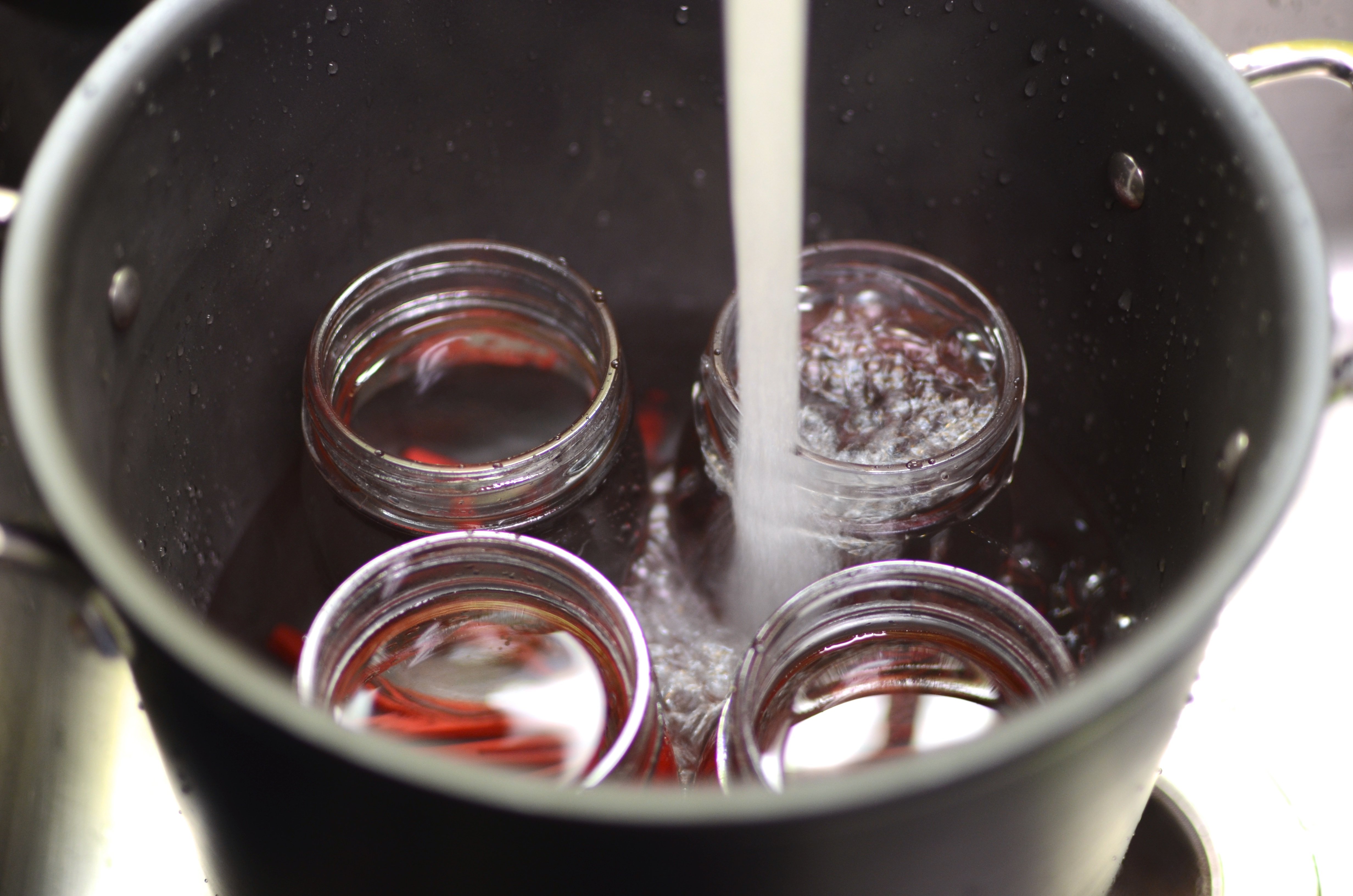
Once your jars squeaky clean, fit your rack into the bottom of the canning pot and arrange your jars on top. Fill the jars with warm tap water and then fill the pot up to the rims of the jars.

Set that pot on the stove, add a healthy splash of white vinegar (this helps keep your jars and pot clean, and if you have hard water, will prevent any minerals from depositing on your jars). Bring the pot to boil and reduce the heat to your lowest simmer, to keep the jars warm.
The rule of thumb is that hot food needs to go into hot jars. While mason jars are designed to withstand temperature changes of up to 90 degrees F, any more of a change could cause thermal shock which will lead to breakage.
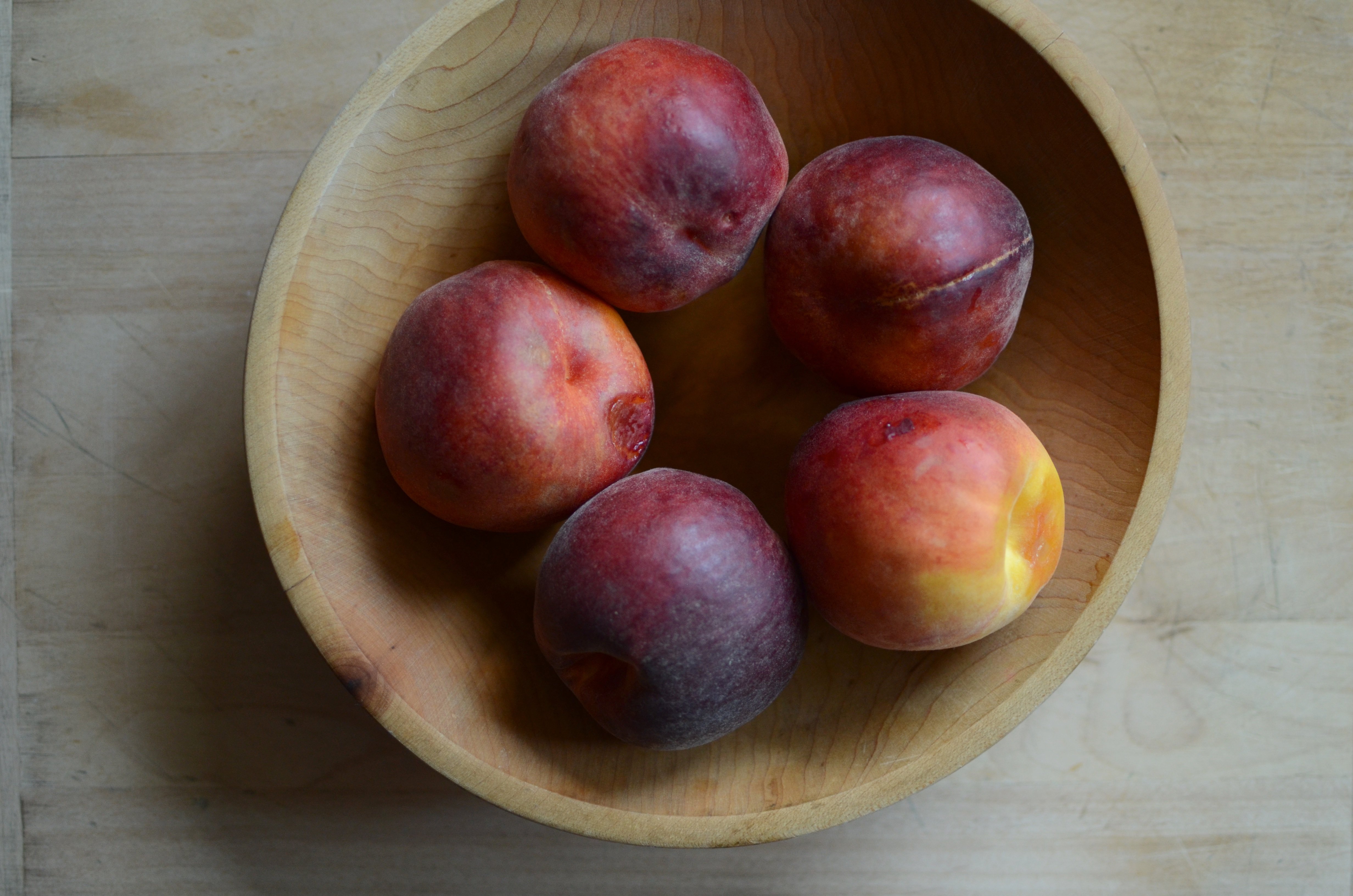
Now that your jars are ready, it’s time to can peaches in syrup. For those of you concerned about sugar, know that it doesn’t really sink into the peaches too much, and will greatly help prevent the peaches from browning. However, if you prefer, you can also pack these peaches in fruit juice. These syrup packed peaches hold their quality longer than the juice packed ones, but are still delicious if used promptly.
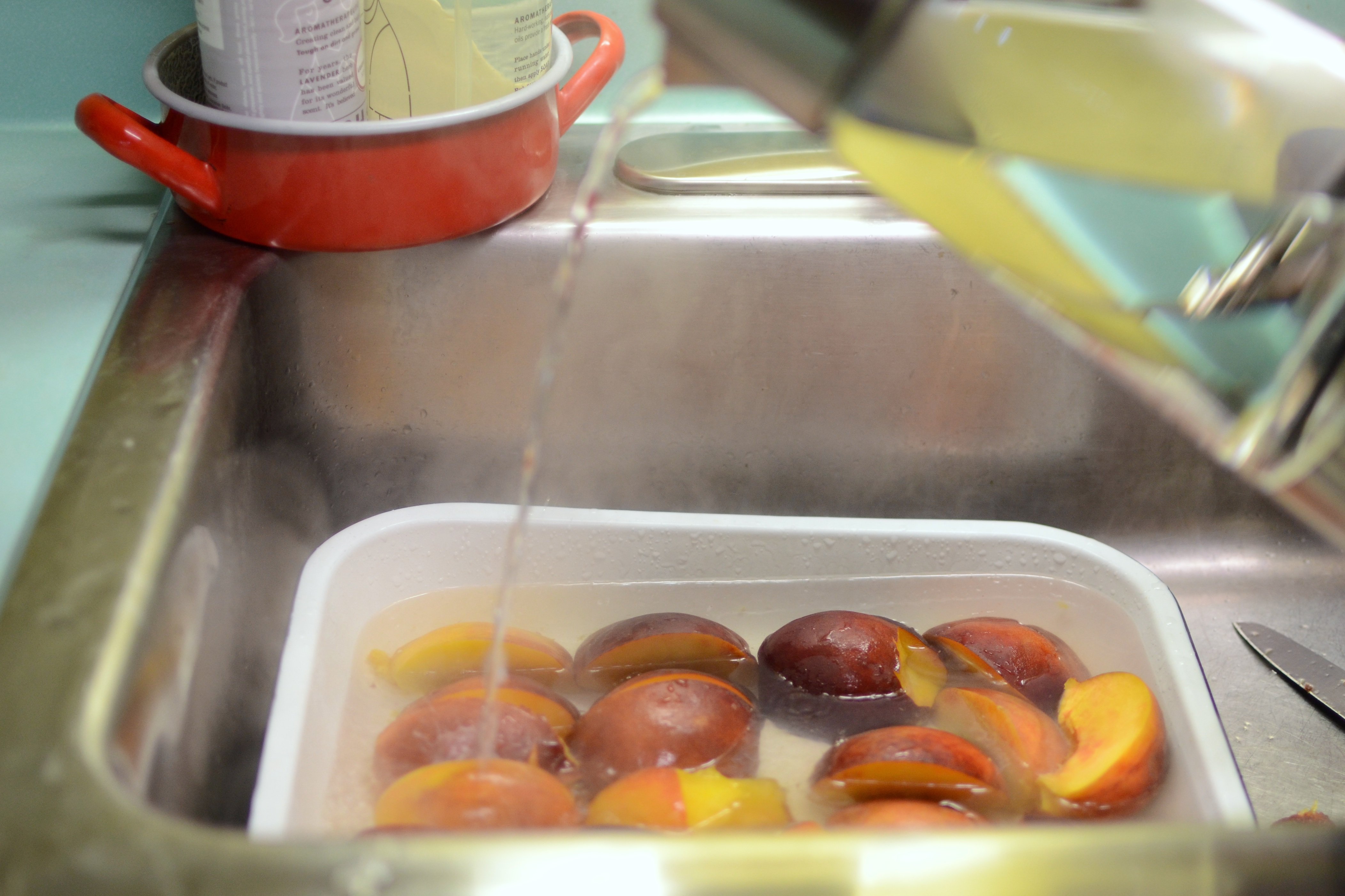
First, make the syrup. Combine 3 cups of water with 3/4 cups granulated sugar in a 4 quart saucepan. Add 2 tablespoons of bottled lemon juice (this is present to help prevent browning) and bring to a simmer. Stir occasionally to ensure that the sugar dissolves.
Cut three pounds of peaches into quarters, remove the pits, and arrange the peaches in a heatproof baking dish (it’s best to do this in your sink). Bring a kettle of water to a boil. Once it is hot, pour it over the peaches and let them sit for 2-3 minutes.
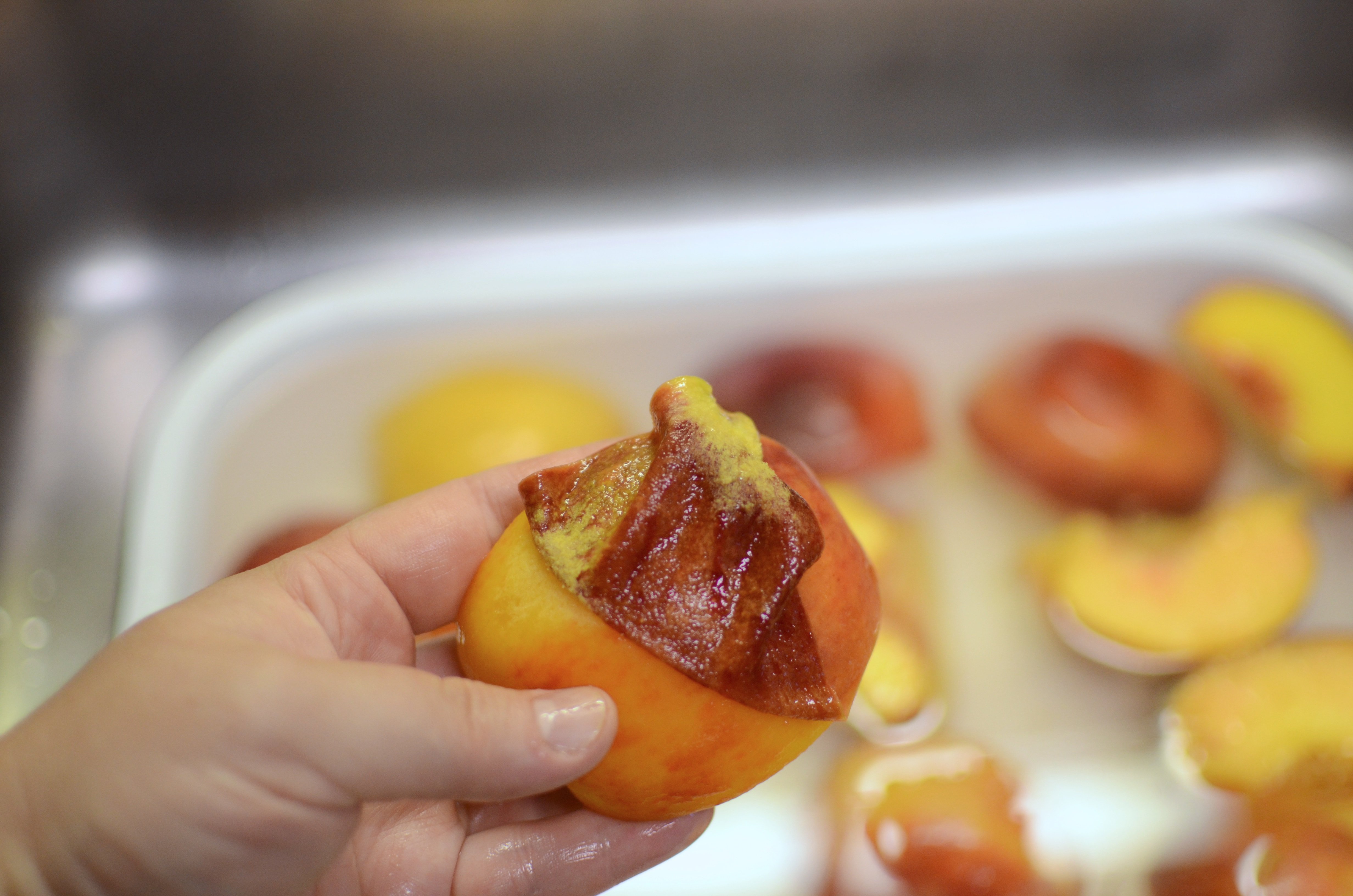
When the time is up, run cold water over the peaches. Provided that the peaches were ripe enough (peeling underripe peaches is tortuous work), the peels should lift off easily. As you work, gently slide each peeled peach quarter into the hot syrup so that the amount of time the peaches are exposed to the air is limited.
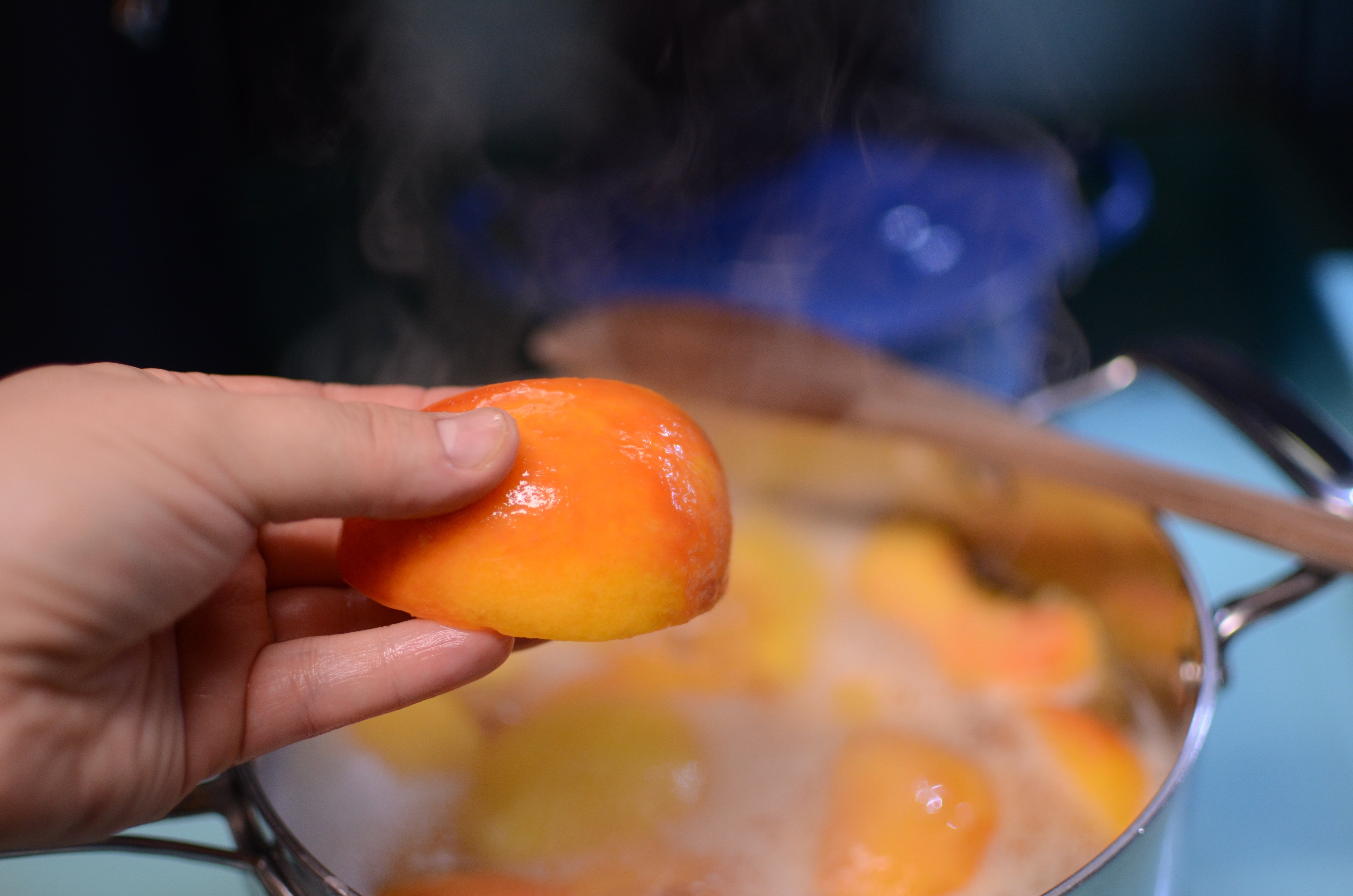
Once all the peaches are peeled and in the pot, bring the syrup to a boil and cook for one minute. Remove the pot from the heat. Pull the hot canning jars out of the canning pot and arrange them on a folded kitchen towel. Position a wide mouth funnel on top of a jar and use a slotted spoon to portion the hot peach quarters into the jars.
Top the jars with syrup and use a utensil like a wooden chopstick or the bubbling tool that comes in the utensil kit to ease out any trapped air bubbles. Fill the jars with syrup, leaving 1/2 inch headspace.

Wipe the rims of the jars with a damp paper towel. Center a clean lid on the jar and apply the ring. Tighten it only until it meets resistance. You don’t want to overtighten it, as that could cause the lid to buckle during processing. Place the jars in the canner, put the lid on, and bring the pot up to a rolling boil. Process the peaches in your canning pot for 20 minutes (if you live at elevations above 1,000 feet, you’ll need to increase your processing time. Check out the chart here).
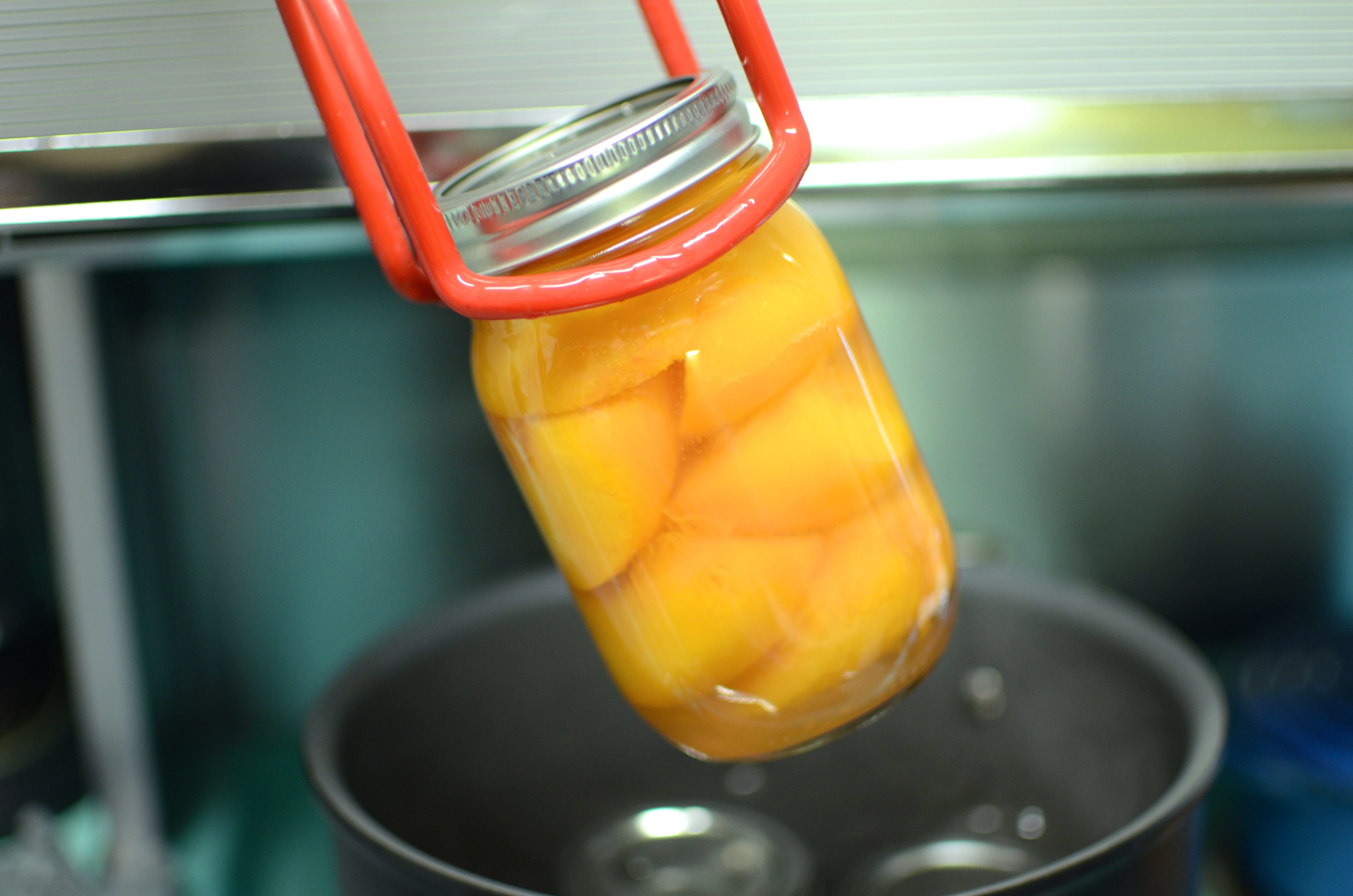
When the time is up, turn off the heat, pull the canner off the hot burner, and remove the lid. Let the jars cool in the canning pot for five minutes (this helps prevent liquid from siphoning out of the jars and produces a stronger seal). Once that time is up, remove the jars from the pot and set them back on the folded kitchen towel.
Let them cool undisturbed for at least 12 hours. Once that time is up, check the seals. If the lids are concave and seem strongly adhered to the jars, you are good. Wipe any sticky residue off the jars and store in a cool, dark place. For the best quality peaches, eat them within a year.

You’ll notice that my finished jars have some air bubbles in them. I bubbled these jars repeatedly during filling, but some bubbles remain. Once the jars have sealed, the bubbles aren’t major concern. The only time you need to worry is if the jar has been sitting undisturbed for many hours and th bubbles are moving towards the top of the jar on their own. That is a sign of fermentation. However, if the bubbles are inactive and simply present, they are not a cause for concern.

Of course. I didn’t think of that. : )
After the empty jars boiled and I turned down the heat, I dropped the lids inside to warm them. How do you get them out? Mine fell under the lifter basket and it was hard to reach them.
(I just read in your other post that you don’t have to do that anymore but I have no idea how old my lids are and I thought they might be older than the new instructions so I did it just in case.)
You can buy a stick with a magnet at the end called a lid wand. That’s what you use to retrieve the lids.
This will be my first time canning peaches, my second time canning anything. It says to fill the pot with water to the rim of the jars. Does that mean to the top of the jar and no higher? I would think the jars need to be submerged in water. Help!
You fill the pot to the rim of the jars when the jars are empty. Then, when you fill them with the product, the jars will displace additional water and they will be fully submerged.
I came on your site for a peach canning instructions and learned True Value sells canning supplies. I was dreading having to drive 15 minutes to the grocery store but was so happy to bike less than 5 minutes to True Value and pick up supplies! And the peaches look amazing!
I’m so glad to hear that this post helped you out like that!
Hi Marisa! I canned some peaches yesterday, and while checking the seals one of the lids was still popped up, however when i ran my finger over it the lid got sucked down and did not pop back up ( I also had a jar of jam that didn’t seal and when I pushed that lid down it popped right back up), i tested it by lifting the jar by the lid and it held. right now the peaches are in the fridge as I’m not sure if the seal is good or not. thoughts?
As a side, I took your pressure canning class this past spring in Hillsdale, NY and just bought my first pressure canner this past weekend. Can’t wait to start using it.
The jars you touched are fine. Sometimes a light touch is enough to help finish the sealing process. And good luck with the pressure canning! I’m sure it will go beautifully for you!
Thanks!
I actually have a question. Your canned peaches seem to have lots of air bubbles ( the first picture on the top). I canned my peaces for the first time last month and mine is the same way. All well sealed. Is that normal? Safe to eat?
It’s normal and safe. I wouldn’t have posted a picture if it was problematic! 🙂
I would like to add a 3rd burner pot to my canning tool box.
Reminds me to put up some pickled peaches….. I too could use a rack for circulation
I’ve been canning for a few years now and I never knew a rack was needed at the bottom of the pot for circulation! Eek! Add that to the list.
I’m so happy I found your blog! Your book “Food in Jars” is my canning go to book … love it! Thsnk you.
Jars. I always want more jars 🙂
We just bought a house with 2 peach trees so I’m excited to make these canned peaches and peach preserves!
A new canning book and other canning supplies.
I need more canning jars. We have a bumper crop of tomatoes this year — going to need more jars.
I’m needing a smaller canner these days. Thank you!
I’d like to get a pressure canner.
I always need jars!
Really would like to start canning with this summer’s awesome harvest at the farmers market!
We just bought a house this summer, so next summer my garden goes in!
I keep trying to find a new place to buy jars. Just plain jars, I don’t want my fruit in a blue jar! 🙂
I need a new trivet for my canning pot!
I’m always in need of jars and flat lids – stores are always out when I go looking for them.
I would love to add a larger stock of wide mouth jars. I have seen how much easier they can be to fill than the regular mouth jars.
Thanks for the chance to win!
wildorchid985 at gmail dot com
Usually Kmart but I need to check out our local True Value. Those prices are better than Kmart.
I always need more jars but what I really need is a new, taller canning pot!!
I would love the magnetic lid remover doo hickey.! I love to can!
This is a welcome post after I couldn’t find any jars in my local stores in my neighbor in philly.
This is a welcome post after I couldn’t find any jars in my local stores in my neighbor in philly. I finally checked out a hardware store and they had them!
A stainless steel funnel would be a great addition to my canning supplies.
I’d love to get a outdoor stove for canning on the patio, i hate heating up the house in summertime/
I have a few things I would like to add. Stainless funnel. Small rack for water bath canning and jars.
One thing I would love to add to my “canning toolbox” is a pressure canner. I have a freezer full of homemade chicken stock and I would love to be able to get it out of the freezer and into jars in my pantry. More realistically, I need lids and pectin, specifically Pomona’s Pectin, for jam making.
i think my canning inventory is pretty well set – although i could always use more jars. 🙂
I need jelly jars.
canned for the first time today actually- jalapeno peppers- and I think it turned out right. I would like to have the thing to put in the bottom of the pot, today I just used a kitchen towel as a bit of cushioning
I need more jars, lids, pectin, pickling spices and salt.
I would love to add jam and jelly jars and look for the quilted ones. That are being discontinued. I love canning.
I’d love to get more jelly and pint jars. There’s never enough!
I love the products at True Value. They have tons of canning goods at the store nearest me, so its easy to run and grab something if I’m out!
Thanks for the excellent peach tutorial. I was inspired to try canning peaches — it’s a big hit! So much so, I could use a larger stockpot. As I tend to do small quantities, I’d like one that can accommodate a few pints yet has a small footprint.
I love the wide mouth half pint jars!
You can NEVER have enough canning jars! Plus I need a trivet.
I’d like a pressure canner
Always could use smaller jars and gift-type jars, taller canning pot, replace some very old canning tools.
I’d like to add a silicone trivet. And smaller sized jars, I can always use more of those!
I’d love to add a stainless steel funnel to my canning supply drawer.
I love canning!! I really could use a magnetic canning jar lid lifter and a new jar lifter insert for my pot.
I pick them up at the thrift stores sometimes..otherwise I do use our local hardward.
While I can always use lids and the various forms of pectin, the thing I really want to add to my food preservation tool kit is learning how to flash freeze.
I bought my 1st canner in a true value.
I always need flat lids and of course pectin! But a headspace measure would also be most helpful! Thank you for the opportunity.
In answer to the original question, I don’t have a True Value close to me, but I have a Fleet Farm that has a full range of canning supplies.
Too funny o find this today. I am going to my local hardware store for jars today. Going to make peach blackberry jam.
I would love a stainless ladle with a pouring lip.
Love the recipes have 25 lbs of peaches to put up
I’d like to get some of the colored Ball jars.
I just canned some peaches yesterday, in a light honey syrup. Only 6 quarts and we really savor them in the middle of winter! Love your posts 🙂
I would LOVE this! Adore this blog!
MaryO1230
San Pedro, CA
On my wish list is a wire basket to lift the cans out of the bath. Right now I use old canning lids.
I would like to add the silicone trivet. I enjoyed your presentation at the library on the 10th!
my local True Value just closed, I was so sad to see them go… they were my go to place for Tatler Lids!
Thanks for the simple and useful hint on getting the skin off a small batch of items. I will definitely be using this technique.
While I don’t need any jars (I have over 700) I would love to try the new smooth side jars. And I always need lids, lots and lots of lids. This week we will be picking peaches.
I pretty much have everything I need. Next thing to add would be a pressure cooker!
New pot, mine leaves the water rusty looking. not good for sterilizing the jars.
I love True Value! Was just there last night.
I’m in near desperate need of a new canning kettle. And I can always use more lids…
I believe in continued education as there can be changes to the ‘rules’ about canning. I also need a new bubble release wand…..I can’t find mine anywhere!
I need more lids!
I need a new big pot for waterbathing. I also would like a new jar lifter.
A nicer funnel than the one I have been using, and definitely more jars and lids. I gave so many things away last year that I’m now facing a serious shortage! Thanks for all the fun giveaways, Marisa!
A trivet would be great to have…and I always need more lids!!
I’d love to get a silicone trivet like yours!
Stainless steel funnel.
I really like our True Value Store. Hardware stores are fun.
I’m hoping to add a pressure canner to my toolbox at some point in the near future!
I’m hoping to add another pressure cooker to my canning tool box.
I’m looking for an insert that keeps floating fruit submerged in the syrup.
More half pint jars and labels for all the jars I make.
I always need more jars and lids though i’m a mutli generation canner as it is a part of life , I give so many away as gifts filled with great goodies , I also always have my eye out for old outdated canners and love to bring these high quality tools back to useful life ,which is really no big feat ,with the parts reddily available often adding a new gasket weight /stem and gauge can save a canner from the recicleing bin and get a beginner started over the biggest hurtle in home canning “affording a pot “
I really like the silicone trivet. I can already see rust on the cake rack I’ve been using. I could also probably use a real canning pot instead of the big soup pot I’ve been using. Only half pint jars fit well.
My local Target has quite a nice selection of canning supplies including some of the fancier things mentioned here. I have a local organic nursery that also has a canning section but he stocks the more basic things.
I can always use more small canning jars.
I always need more lids.
Jar weights for fermenting…..the one that fit into the quart jars.
I’d really like one of those silicone trivets. My mom’s (which may have been her mom’s) canning rack is rusted and just not nice any more.
I need to replace my jar lifter. The rubber has worn off and it slips sometimes!
I need a headspace measurer. I always just eyeball it!
I would love to have some smaller canning jars. I only have large ones.
I’d always like to add more jars and lids. One thing I’d really like as well is a smaller pot, so when I have small batches I don’t have to lug out the big one.
My mom used to can peaches every year, and it was so lovely to eat them in the dead of winter.
I’d love a silicone trivet; I currently use an old and rusting canning rack that really needs replacing.
I could use a flexible silicone trivet, a wide mouth funnel and more flat lids.
Jars and lids! especially jars! Thank you!
Flat lids!! I feel like I always run out “JUST” when I’m ready to take on a new project. I want a stockpile at the ready.
You’ll laugh, but I want to add some disposable lids to my canning supplies! I switched to Tatter years ago and love that I reuse them over and over and never have to worry abou tnot having lids (except when I canned up everything I had last year) and that I don’t spend money on lids. But this year I’m going to be gifting to people who may not return lids and also possible selling a few to friends for gifting. So I need disposable lids!
Heather
more jars!
I would get a new trivet. I have the same silicone one as you but it tends to float around after I take the jars out and I have to use two spoons to flatten it to put the jars back in for processing. I would also like to get some of the colored jars!
I want to try pressure canning!
I’m probably going to look for a rack that fits my pot better. The one I have was from the Ball starter kit, and while it’s great, it’s a stretch to put 4 jars in at once, and my pot could definitely hold a rack with a bigger diameter.
Always more jars and lids!
I can always use more wide-mouth jars.
I’d like to add a new stock pot. Mine were very cheap and have gotten a bit dingy.
I had not heard of a device to get rid of bubbles; I use a chop stick.
I would love to find a small stainless steel ladle for jar filling. I have a plastic one now that I love, but wish it was metal for longevity.
I definitely need a rack to lift the jars of the bottom of the pot, that’s my next purchase. And I need it soon, peach season is upon us!